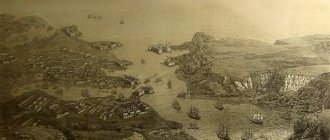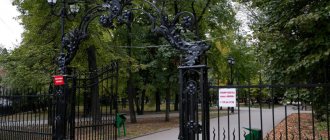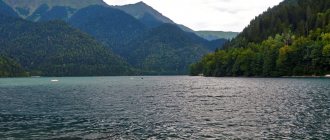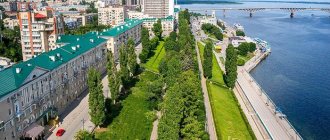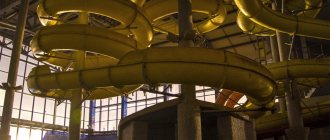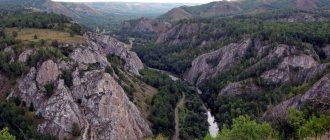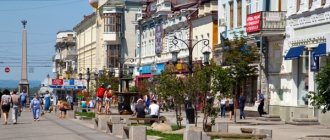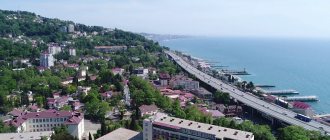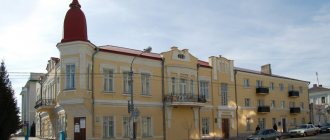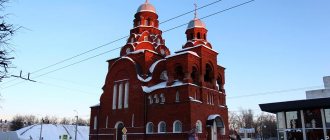Category: Museums and monuments
Saratov is a fairly young city when compared with most other cities located on the Upper and Middle Volga. So initially in all historical documents it was referred to as “Young City”. Today, this “young city” has more than 400 years of history, which the city’s residents carefully preserve. And the memory of outstanding events and personalities is captured for centuries in the form of memorials, sculptures and monuments, of which there are many installed in the city.
Monument to the fighters of the 1917 revolution
Thus, in the center of the city, in the garden of the Radishchevsky Museum, on the site of the mass grave of the fallen fighters for Soviet power, stands the monumental composition “Monument to the Fighters of the 1917 Revolution.” It was first installed here almost 100 years ago - in November 1918. But during this time it has undergone many fundamental changes and in the form it is now installed only in 1987. At first it was a wooden obelisk, then a memorial stone, in 1957 a concrete monument appeared here, which in 1987 was replaced with a bronze copy.
And today this monument remains one of the main Saratov monuments of the Soviet era.
Gate of St. Nicholas Church
The arch of the holy gates of the Vladimir St. Nicholas Church is almost all that remains of the majestic Holy Cross Monastery that stood on this site.
The first mention of the monastery dates back to 1680. In June 1722, Peter I visited Saratov while traveling to Astrakhan. Since the main Trinity Cathedral was under repair, the tsar attended a liturgy and prayer service in the monastery Church of the Exaltation of the Cross.
On the eve of the October Revolution, the Holy Cross Monastery consisted of 17 nuns, including the abbess and treasurer, 16 novices, 7 schema-nuns, 41 supernumerary nuns, 333 supernumerary novices. In 1918, the monastery lost its land. The work of workshops and schools was curtailed. Some of the novices went into the world. Those who remained tried to somehow hold out, even tried to call themselves a labor collective. Abbess Antonia organized a community of believers at the Church of the Exaltation of the Cross, and turned to the provincial executive committee and other authorities for help. But in vain. On April 5, 1919, the ancient Church of the Exaltation of the Cross was taken away from the monastery under the pretext of storing in it valuables seized from city churches as museum curiosities. At the beginning of 1922, the convent was liquidated, and the last St. Nicholas Church was closed and soon blown up.
It was probably purely by chance that the gates remained from the St. Nicholas Church, which today are a unique monument of architecture and history. The gate attracts the attention of both city residents and tourists - after all, it is located fifty meters from Museum Square - the site of the founding of modern Saratov.
Unfortunately, for a long time there was no information board or memorial plaque next to the monument. Therefore, lovers of homemade excursions could only guess what kind of gate it was that led nowhere.
Black and white Saratov
Today the gate has been restored and has a memorial plaque.
Monument "Cranes" in Saratov
And the memory of their fellow countrymen who died during the Great Patriotic War was immortalized by Saratov residents in the “Cranes” monument, made by sculptor Yu.I. Menyakin. It consists of three 40-meter pylons crowned with a star and twelve cranes. Its grand opening took place in 1982 on Victory Day in Victory Park on Sokolova Hill. There is also an eternal flame, a stone in memory of those killed and five platforms marking the milestones of the war years.
Many monuments in the city were erected in memory of famous personalities, one way or another connected with Saratov.
Remnant "Three Monks"
The erosional remnant “Three Monks” - a geological natural monument - is located in the middle part of the eastern slope of Sokolovaya Mountain, near the village of Zaton. The remnant is a witness to the once large erosion block located here, the only one in the region that is large and clearly morphologically expressed.
Only in its walls are the structural details of part of the Lower Cretaceous sediments clearly visible - cross-bedding, the “cone-in-cone” structure, the structure of nodules and other features reflecting the dynamics of the marine paleobasin of the Aptian age of the geological history of the Earth. The remnant is gradually undergoing physical weathering, so it is necessary to protect it, and use it only from the standpoint of ecological tourism. From the site of the remnant there is a wonderful view of the Volga, which in this place spills up to three kilometers, the longest bridge in Europe and the Green Island.
Several legends are associated with the “Three Monks” (popularly the remnant is also sometimes called the “Devil’s Finger”). Even in guidebooks to Saratov in the 19th century, it was listed as a local attraction and, as we can suggest, inquisitive tourists were taken to the remnant.
The erosional remnant is located on an ancient landslide body. Length – 30 meters, width – 5-6 meters. The inclination angle of the western slope is 60 degrees, the eastern slope is 90. The height of the western slope is 10 meters, the eastern slope is 20 meters.
A little geology. The remnant is composed of gray sandstone. The composition is quartz. The structure is fine-grained. Texture – thin horizontally layered. At the base of the erosional remnant in the sandstone there are loaf-shaped bodies up to 1.5 meters in diameter, composed of interlayered sandstone and clay.
Guide to Saratov
Monument to P. A. Stolypin
So, on the Stolypin Square there is a monument to this very statesman. It was opened in April 2002, when Saratov residents celebrated the 140th anniversary of the birth of Pyotr Arkadyevich Stolypin, the main reformer of Russia, who at one time was the Saratov governor and prime minister of the Russian Empire.
The author of the monument was V. M. Klykov, who borrowed the idea of creating it from the previously existing monument to Emperor Alexander II. In the center of the composition is a 3.5-meter figure of Stolypin, and on four sides of it there are four sculptures: a warrior, a peasant, an Orthodox priest and a blacksmith - symbols of the reforms and policies of the Prime Minister. The pedestal of the monumental composition is decorated with the famous words of the reformer: “We need a great Russia.”
Giant Oak on Kumysnaya Polyana
There are more than a dozen species of oak in the forests of Russia. The Saratov giant oak belongs to one of the most common species - pedunculate oak. It is the pedunculate oak that is sung in the lines of songs and other folklore works of the Russian people.
According to experts, its age is approximately 200 years. The height of the giant oak is 30 meters. The trunk with a girth of 2.5 meters is covered with rough bark, riddled with deep cracks. The branching of the tree begins at a height of about 3.5 meters. The gnarled branches are covered with knobby thickenings; their diameter at the base reaches 0.5 meters. The giant's crown is highly branched and has an irregular, broadly conical shape. The area covered by the crown is about 150 m2.
The giant oak grows at the bottom of a shallow ravine in the upper reaches of a large forest ravine. Next to it, on the slopes of the ravine, there are high (up to 20-25 m) thickets of linden, maple and elm. Due to this, in recent decades, the lower part of the oak crown has been shaded. Surrounded by other trees, the oak began the process of natural “self-cleaning” of the trunk - the lower, oldest and largest branches began to dry out. However, as foresters say, oaks like to grow “in a fur coat, but with an open head.” In other words, this tree requires side shade and does not tolerate shade from above.
Thus, the proximity of tall trees does not create any special problems for the giant oak. The upper part of its crown, starting from 12-15 meters in height, continues to develop normally. This is evidenced by the smooth, greenish-gray surface of young shoots, dark brown bark and healthy wood of recent growth with a vaguely pentagonal core. Despite his advanced age, our patriarch periodically showers the surrounding area with acorns.
The senile state of the giant oak is still very far away: the usual lifespan of the pedunculate oak in the forest-steppe zone of Eastern Europe is 500-600 years, but trees twice that age are known. The Saratov giant oak provides an excellent example of the biological potential of this valuable forest-forming species in our steppe zone conditions, which are far from optimal for afforestation.
Saratov. Tourist portal
Bust of A.N. Radishchev in Saratov
There is also a granite bust of A. N. Radishchev in the city. It is installed opposite the museum of the revolutionary writer, in the garden that bears his name. At first it was a plaster monument, but over time it was replaced with a granite counterpart. Its author is sculptor A.P. Kibalnikov.
There are also quite original monumental creations in Saratov. One of them is the so-called “Heart of the Province”.
Stories, routes and tourist tips
Perhaps, when planning your trip, you will find the stories of tourists who have already visited Saratov, as well as the stories of local residents, useful. It is from there that you can often learn about unusual places, get unusual ideas and interesting routes.
We invite you to get acquainted with the real reviews of our tourists:
- Anna’s stories about her recent trip to Saratov “Front facades of Saratov” and “Walking along Moskovskaya”
- A story about the architectural pearls of the city “Saratov Art Nouveau, flour kings and their architects” from Evgenia
- The story “In the Footsteps of the Golden Calf” from local resident Victor
- The story “Walk around Saratov” from Sergei
Reviews from tourists about a trip to Saratov on Tourist. RU
Do you know that the site has a “Questions and Answers” ? It exists so that you can, if necessary, check with experts for up-to-date information about attractions or get advice on issues that interest you regarding your planned trip to Saratov.
Monument to Oleg Yankovsky at the Drama Theater named after. I.A. Slonova Photo: © Anna Kudryavtseva
Monument “Heart of the Province”
This is a modern Saratov monument, a pseudo-abstraction by sculptors Sergei and Andrei Shcherbakov, symbolizing the activities of the government apparatus, which is located near the government building. The monumental “Heart” is surrounded by administrative buildings, in which, according to the authors, the driving force of the province is concentrated.
The sculptors presented a truly original, meaningful work, but Saratov residents perceived it ambiguously and dubbed this bronze sculpture “myocardial infarction.” You can see other interesting monuments in Saratov.
Saratov monument to lovers
The city has a beautiful tradition associated with the monument to lovers, installed on the Cosmonauts embankment in 2000: on the wedding day, ribbons and bells are tied to it as symbols of a long and happy married life. True, this quickly established tradition has changed the monument beyond recognition, and now it is not possible to discern the artist’s original plan.
Makhannaya ravine
Makhannaya ravine is located to the north of Sokolovaya Mountain. You can go down the slopes into it and continue your natural history excursion, or, after passing through the ravine from west to east, you can reach the Volga coast.
Makhannaya Ravine is a very large, deep, highly branched and intensively growing ravine, which stretches in a sublatitudinal direction and is the northeastern border of the Sokolovogorsk massif. The formation of the ravine occurred in the Holocene, i.e. several thousand years ago, on the site of an extensive trough-shaped depression - a wide beam opening towards the Volga. The length of the ravine is more than 2 km, the depth in some areas exceeds 40 meters, the walls are steep and steep, complicated by landslides.
At the bottom of the ravine, a new ravine develops, along which the Bezymianny Stream (Makhanka River) flows, and two small lakes are formed.
The name of the ravine, apparently, comes from the Tatar-Turkic word “mahan” (horse meat): as if the corpses of fallen horses were once thrown into the ravine.
The Makhannaya ravine has several openings of the first and second order, especially the right side of the ravine is cut by them. The screwdrivers rapidly develop in length and width.
Black and white Saratov
Saratov. Tourist portal.
Monument to the song “So many golden lights...”
Here, on Kirov Avenue, in August of the same year, 2009, another musical monument was erected - a monument to the song. Naturally, we are talking about a musical composition that we associate with Saratov - “So many golden lights...” The monument is a sculpture of a young man from Soviet times, standing with a bouquet under a clock. By the way, in the face of this young man you can clearly see the features of the author of the composition - Saratov sculptor Nikolai Bunin.
It is among the top 20 largest cities in Russia.
2. Saratov is located on the banks of the huge Volgograd reservoir.
3. Before the city was founded, here in the 13th century there was a settlement of the Golden Horde, called Uvek (Ukek), which was a developed city at that time; it was even mentioned in the records of the famous traveler Marco Polo.
4. Local residents were artisans, traders and farmers. They even minted their own coins here.
5.But the city was destroyed as a result of the invasion of Khan Tamerlane. Since then, only the ruins of city buildings and mausoleums with burials, and various household items have been preserved.
6. Saratov was founded as a guard fortress at the end of the 16th century. First, in 1590, it was located on the site of the current Anisovka railway station. But then the city burned down in a fire; it was rebuilt again in 1617 near the Saratovka River.
7.But in 1674, it was re-founded by order of Tsar Alexei Romanov near the Volga as a defensive fortress in the southern territories of Russia, which was supposed to be a defense against the invasion of nomads.
8. In the second half of the 17th century, the Peasant War broke out in Saratov under the leadership of Stepan Razin. Since then, there has been a well-known and influential Cossack community in the city.
9. In the middle of the 18th century, this territory was still sparsely populated, therefore, according to the decree of Catherine II, foreign colonists were invited here. Quite a lot of German-speaking residents moved here.
10. Immigrants from Germany, Holland and Poland, having settled in these lands, founded here the production of a successful fabric - sarpinka, which was sold in European countries.
11. In the last quarter of the 18th century, the impostor Emelyan Pugachev, who called himself Emperor Peter III, tried to seize power in the city. On August 6, 1774, the rebels laid siege and captured the city the next day. But after 4 days, Saratov was liberated again and found itself under the control of the imperial army.
12. After the Patriotic War of 1812, French prisoners of war were exiled to restore the city, and many of them not only subsequently became subjects of Russia, but were also recruited by the local nobles for the purpose of teaching their children French.
13. Saratov is surrounded on three sides by low hills - no higher than 250 meters.
14. Some time ago there was a project to unite Saratov with Engels, its satellite city, but due to opposition from residents it was decided to abandon it.
15. The area of Saratov is larger than the area of countries such as Grenada and Malta.
16. Already at the beginning of the 20th century, Saratov occupied 1st place in population among the Volga cities, but now it has been overtaken by Volgograd.
17.Currently 838,042 people live in Saratov.
18. At the end of the 19th century, a horse-drawn railway operated regularly here, operating on five routes and connecting the city center with several significant areas. It remained in service until the city authorities replaced it with a tram. Horses led by a coachman pulled a trailer that could accommodate 24 passengers.
19. At one time, the post of governor of Saratov was held by the reformer Pyotr Stolypin, who during his tenure managed to make a significant contribution to the development of the city. On his initiative, hospitals, shelters, and educational institutions were built.
20. The Saratov Aviation College, known today, occupies the former Mariinsky Women's Gymnasium, which was founded by the governor at one time. Huge amounts of money were allocated for improvement: for asphalt streets, for gas lighting, for modernizing the telephone line. Today the Volga Region Institute of Public Service is named after its famous governor.
“HUMPBACK” BRIDGE IN GORPARK
21. Saratov is a city rich in attractions. This is Kirov Avenue, the embankment, several parks, the “humpbacked” bridge and others. Also, a short distance from the city center there are places that will be of interest to tourists.
22. Saratov Regional Universal Scientific Library is one of the oldest libraries in Russia. It was opened on March 4, 1831 on the initiative of the President of the Imperial Free Economic Society, Admiral N.S. Mordvinova. Since 1856, the library has been officially called a public library.
23. Today, probably, everyone already knows that Saratov was the birthplace of the outstanding Soviet actors Oleg Tabakov and Evgeny Mironov.
24. A native of Saratov is a physicist, chemist and teacher, the founder of chemical physics, who made a significant contribution to the development of chemical kinetics, N.N. Semenov, who became the only Soviet citizen to receive the Nobel Prize in Chemistry.
25. The first children's theater, circus and first museum appeared in Saratov earlier than in all other cities in the region.
MUSEUM NAMED AFTER RADISHCHEV
26.By the way, this is the first public museum in the history of Russia, known today as the Saratov Art Museum named after Radishchev. It was opened in 1885, and in the year of its opening more than 60,000 art fans visited it.
27. Now the museum's exhibition consists of 30,000 works, including paintings by Repin, Bryullov, Shishkin, Korovin, Serov, Levitan, and this is only a small part of the artists whose works occupy the main places of the museum.
28. Winters here are cold. The soil in the city sometimes freezes 1-1.5 meters deep. On the hottest day, the temperature was recorded at plus 40.9 degrees Celsius, and on the coldest night - minus 37.3 degrees.
29. The former bank building is a bizarre combination of pre-revolutionary classicism and Soviet sculpture of the post-war period. The history of Saratov knows this building as the “City Public Bank”. Located on Teatralnaya Square in the Volzhsky district of the city. Currently known as the Palace of Children and Youth Creativity named after O. P. Tabakov.
30. It was in Saratov that mechanized steam mills first appeared in the Russian Empire. The Schmidt family, who moved to these parts, built the first such mill here, after which the flour milling craft became very prosperous. At that time, these mills were very modern. Therefore, for decades the city bore the unofficial title of the flour capital of Russia.
INDOOR MARKET
31. One of the symbols of the city is the luxurious indoor market, opened more than 100 years ago. The indoor market is located in the center of Saratov; it was built in 1916 according to the design of the architect V. A. Lyukshin. The building occupies a block from Kirov Avenue to Vasily Lyukshin Street. The main facade faces Chapaeva Street. The construction of the new market was intended to improve the city and rid it of unsanitary conditions, as well as to move street trading to comfortable buildings specially designed for this purpose.
32.The covered market was built under the influence of advanced design trends of the time: frame system, use of steel trusses, new materials. This example of architectural and engineering thought involved central heating, the use of electric lighting, the installation of powerful refrigerators in the basements of the building and electric elevators. The combination of glass entrance and window openings with reinforced concrete structures gives expressiveness and lightness to the building. Thanks to the difference in roof height and the glass dome, the lantern was able to illuminate the trading floor with full daylight and create the impression of spaciousness.
33. Saratov is famous for the birth of the famous Saratov harmonica.
34. Saratov is a city of dozens of architectural attractions, including historical buildings, architectural masterpieces, unique projects of Saratov architects.
35. Saratov has many interesting and unusual buildings erected in different years. Saratov architecture is diverse - it presents both traditional classics, embodied in city mansions and churches, as well as more modern modernism and socialist constructivism.
HOLY TRINITY CATHEDRAL
36. Holy Trinity Cathedral - the first stone cathedral of Saratov, one of the oldest churches in the Lower Volga region; monument to the Naryshkin Baroque. It was built in 1674-1675 with the blessing of Metropolitan Parthenius of Astrakhan and Terek. The cathedral is an object of cultural heritage of Saratov of federal significance. The temple has its own museum, which occupies two rooms in the administrative building.
37. The cathedral, like Saratov itself, repeatedly suffered from fires, and in 1684 it burned to the ground. The following year, the temple was restored as a wooden church with the blessing of Metropolitan Savvaty of Astrakhan. In 1695, construction of a stone temple began. According to legend, the then Tsar Peter I, who was in Saratov on his way to Azov, climbed onto the scaffolding of the cathedral.
38. An unusual architectural structure is the Saratov house on Gogol Street, which very much resembles an inverted bottle. Although the bottle house is not listed as an architectural monument, and its inventory number is not included in any registers. But, nevertheless, this is a monument to architectural thought and an original view on the possibilities of construction. The building is ancient; this, for example, can be judged by the figured window in the form of a keyhole. Previously, the house had a dome. Its brickwork and Gothic windows indicate that this structure is ancient. Unfortunately, the history of this house is unknown.
39. Hidden among the skyscrapers and old private houses in the area of Predmostovaya (Slavyanskaya) Square is one unique house. At the address st. Lermontova, 65, in the courtyards in the shadow of the Panorama residential complex, there is an inconspicuous two-story house. With a dilapidated façade that is about to fall apart. However, the house has the highest status - a cultural heritage site of federal significance! It is known as the Dyakonov House, the oldest residential building in Saratov. It is believed that it was built in the first half of the 18th century. Of the buildings that exist today, only the Trinity Cathedral was built then. According to local historians, a customs house or prison was located here.
40. House-commune “Worker”, built in Saratov in 1928-1929, is a striking architectural and social phenomenon of the 1920s - early 1930s, not only in Saratov, but throughout the country. These houses became the embodiment of the proletarian idea of “socialization of life” and one of the manifestations of the era of constructivism. The communal house is located on Proviantskaya Street - one of six experimental demonstration houses built for the life of the new Soviet people, who will build a new way of life in it.
HOTEL "ASTORIA" IN SARATOV
41. Astoria is a hotel in the center of Saratov. One of the architectural symbols of the city. An architectural monument of the early 20th century, an example of late modernism, is the oldest hotel in Saratov. A strict, clear silhouette of the hotel, geometrically impeccable, somewhat sharp lines of the facade. The rhythms of pilasters dividing narrow rectangular windows, massive pylons stretching to the full height of the building, on which medieval knights-ritters stood majestically, an open gallery on the fourth floor, an attic unusual for Saratov houses. In Russia, all these techniques were used only in Moscow and St. Petersburg. That’s why “Astoria” has a metropolitan look.
42. A native of Saratov, the grandson of Radishchev, the landscape artist Bogolyubov, who lost his heirs, bequeathed to the city his own works and a large collection of Russian paintings, for which a mansion was specially built in 1885.
43. Few people know about the Tillo house, despite the fact that it is the only mansion in Saratov made in the Moorish style. It was built in the mid-19th century by merchant Pyotr Fedorovich Tyulpin. But after living in it for quite a short time, Tyulpin, being an honorary citizen of Saratov, sold the house to Vice-Governor A.A. Tillo. It was during Alfred Andreevich’s residence there that the house was literally transformed. The courtyard had its own stable, a very beautiful fence, a sewer system, which was a novelty for Saratov, in a word, the courtyard acquired a beauty unprecedented in those times.
44. People from all over the Volga region come to Saratov for education and work, and also to get to know the city, that is, as tourists.
45. The Tyulpin estate was built in the 1840s with the money of the merchant of the first guild, Pyotr Fedorovich Tyulpin. The Tyulpins' estate is the most complete, indicative example of urban estate construction in Saratov from the time of classicism. The Tyulpin estate is a compact complex of residential and auxiliary buildings surrounding a courtyard. The main one-and-a-half-story building faced Tsaritsinskaya Street with its front façade. His decorations are not rich, but one can feel good professionalism in everything: in the balance of proportions, clarity of composition, severity of details.
COSMONAUTS EMBANKMENT
46. The legendary Yuri Gagarin also trained in Saratov, who, ironically, landed after his flight in the vicinity of the same city. In honor of this event, the no less famous Saratov embankment was named Cosmonauts Embankment.
47. And not only the Cosmonaut Embankment, but also many of its other attractions, such as Victory Park and the Cranes Memorial, Lipki Park, Kirov Avenue and the city park can make an indelible impression on the guest of this ancient merchant city.
48. Beautiful and unusual buildings attract the attention of numerous tourists in Saratov, primarily with their appearance, but usually such wonderful buildings also have a rich and interesting history, which adds attractiveness in addition to their appearance.
49. Saratov is one of the largest in its region, and it has long become a local center of economy and industry.
50. To get acquainted with the history and culture of the Volga region, many tourists visit the city of Saratov every year.
photo from open sources
Monument to the first teacher
And at the intersection of Moskovskaya and Solyanaya streets, the oldest monument to a teacher in Russia was erected. This is part of a previously existing monumental composition to Alexander II, from which today only the sculpture of the first teacher, a symbol of the reform of public education, and her student have survived.
There are two more original sculptures on the topic of education in Saratov - a sculpture depicting a student tortured by his studies and schoolchildren cast in bronze - the so-called sculptural composition “Classmates”.
How to get there
Saratov is located at the intersection of railways and highways, so getting to it is not difficult:
- By plane. It is possible to get to Saratov by air from Moscow, St. Petersburg, Simferopol and Surgut. The flight from Moscow to your destination will take about an hour and a half, the ticket price is approximately 4,500 rubles. Saratov Airport is located within the city - on Zhukovsky Street, 25. You can get to the center by bus No. 90 and minibuses No. 31, 45, 65, 89, 115.
- By train. You can get to Saratov by rail from almost any city in Russia. From Moscow there are several daily flights from Paveletsky and Kazansky railway stations. Travel time ranges from 15 to 17 hours. Ticket prices range from 1000 to 10500 rubles. The railway station in Saratov is located on Station Square, building 1. You can leave the station by buses No. 246, 253, 284, 379, 491, trolleybuses No. 1, 2, 10, 15, 16, minibuses No. 3, 25, 45, 48 , 54, 60, 64, 65, 67, 72, 75, 76, 79, 82.
Saratov railway station traces its history back to 1871 - By bus. This type of transport can also be used to get to Saratov from many Russian cities. More than ten flights depart from Moscow daily. Travel time takes from 13 to 15 hours, the ticket price is approximately 1,600 rubles. The Saratov bus station is located on Moskovskaya Street, building 170. You can go to the center using the same transport as from the bus station.
- By car. Several routes lead to Saratov: P228, E38, P158, P226, P234, P208. Getting to the city will not be difficult for tourists from any locality. From Moscow to Saratov there are about 850 kilometers, which can be covered by a personal car in twelve hours. You should leave the capital along the M4, M5 or M6 highways.
